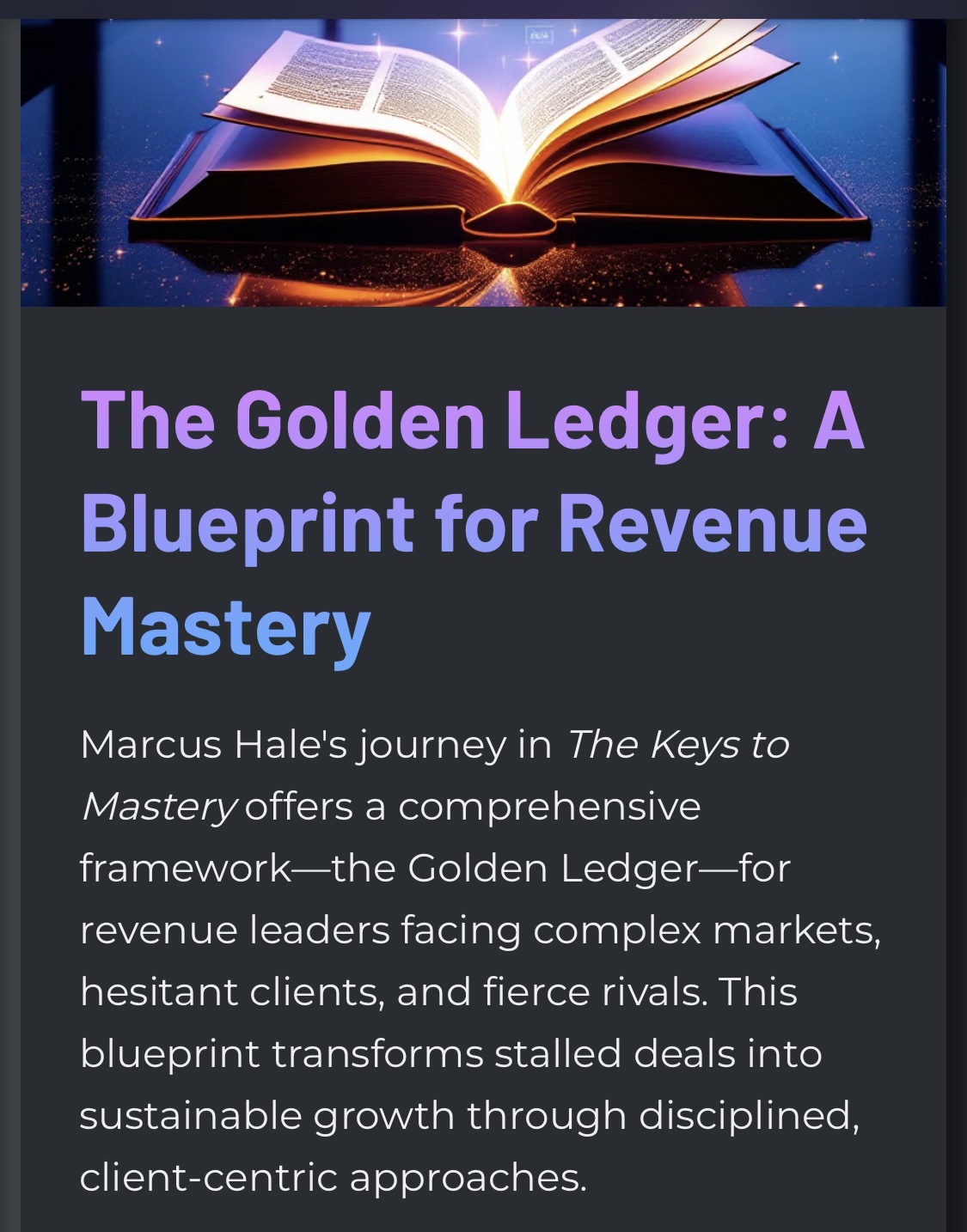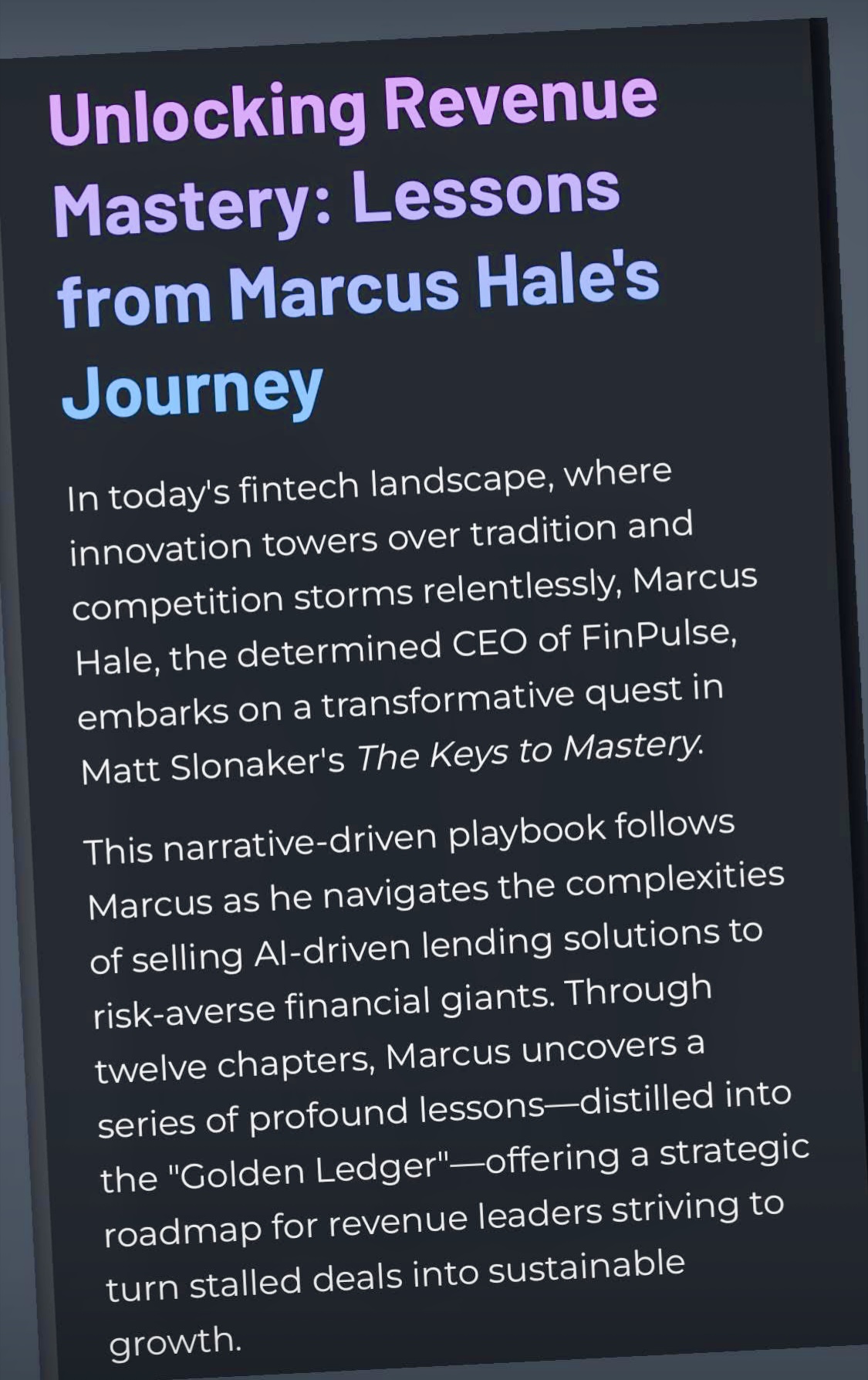A Look at My Upcoming Book
Apr 03, 2025
Unlocking Revenue Mastery: Lessons from Marcus Hale’s Journey in The Keys to Mastery
In the current fintech landscape, where innovation towers over tradition and competition storms relentlessly, Marcus Hale, the determined CEO of FinPulse, embarks on a transformative quest in Matt Slonaker’s The Keys to Mastery: Unlocking the Golden Ledger of Revenue Mastery. This narrative-driven playbook, building on Slonaker’s earlier work The Art & Science of Selling (2024), follows Marcus as he navigates the complexities of selling AI-driven lending solutions to risk-averse financial giants. Through twelve chapters and an epilogue, Marcus uncovers a series of profound lessons—distilled into the “Golden Ledger”—offering a strategic roadmap for revenue leaders. Here, we explore the key lessons Marcus learns and the actionable takeaways Slonaker provides for CEOs and CROs striving to turn stalled deals into sustainable growth.
Marcus Hale’s Journey: Key Lessons Learned
- Stalled Deals Signal Opportunity, Not Defeat
Marcus begins in Chapter 1, “The City of Stalled Deals,” facing a familiar fintech dilemma: despite FinPulse’s cutting-edge AI platform, enterprise sales cycles with banks and insurers stagnate. Rather than despair, he learns to diagnose pipeline bottlenecks as a call to action. Inspired by the mythical “Golden Ledger”—a symbol of flawless GTM execution—Marcus rallies his team to reassess their approach, recognizing that revenue mastery starts with understanding where and why progress falters.- Alignment Turns Silos into Strength
In Chapter 2, “The Mentor in the Vault,” Marcus meets Solon, a seasoned fintech strategist who reveals that FinPulse’s siloed structure—sales chasing deals, product iterating alone, marketing disconnected—is a liability. Solon’s “GTM Mastery” blueprint, with its pillars of Insight, Precision, and Scale, teaches Marcus that cross-functional unity is the foundation of a revenue engine. This lesson transforms frustration into a collective mission, breaking down barriers to accelerate deal flow.- Data Illuminates the Path to Relevance
Chapter 3, “The Data Mines of Insight,” finds Marcus digging into client data to pinpoint pain points—banks crave faster underwriting, insurers demand robust risk models. He learns that innovation without insight is aimless; leveraging analytics to refine FinPulse’s AI offerings yields a 30% reduction in underwriting time, proving data is the currency of competitive edge.- Messaging Must Speak to ROI, Not Features
In “The Tower of Targeted Messaging” (Chapter 4), Marcus discovers that generic pitches drown in the noise of a crowded market. Guiding his marketing team to craft concise, ROI-focused messages—e.g., “30% faster underwriting, enhanced risk precision”—he learns that resonating with C-suite priorities (cost efficiency for CFOs, risk mitigation for CROs) cuts through skepticism, securing a pivotal demo with a bank VP.- Credibility Bridges Trust Gaps
Chapter 5, “The Bridge of Credibility,” reveals that technical brilliance alone won’t sway risk-averse executives wary of security and integration risks. Marcus learns to build trust with data-backed case studies and tailored pilot programs, turning FinPulse from a vendor into a strategic ally—a lesson cemented when a bank CIO greenlights deeper collaboration.- Channels Amplify Reach and Relationships
In “The Network of Channels” (Chapter 6), Marcus embraces a multi-channel strategy—webinars, whitepapers, and social media—to establish thought leadership and engage decision-makers. He learns that a coordinated approach, syncing marketing with sales, transforms awareness into action, as when a whitepaper download sparks a call from a top insurer.- Resistance Yields to Unified Solutions
Facing the “Firewall of Resistance” in Chapter 7, Marcus confronts IT and procurement skepticism head-on. He learns that objections—security, compatibility, cost—are opportunities when met with a united front: sales reframing concerns, product adapting to legacy systems, and marketing showcasing compliance. A bank pilot approval proves adaptability dismantles barriers.- Execution Fuels Revenue Reality
Chapter 8, “The Engine Room of Execution,” teaches Marcus that synchronized operations—product innovation, marketing momentum, sales precision—turn intent into results. Celebrating a seven-figure bank deal, he learns that flawless execution, refined through data-driven optimization, is the heartbeat of sustained growth.- Scale Balances Ambition with Stability
In “The Skyline of Scale” (Chapter 9), Marcus expands FinPulse into insurance markets, learning that scaling requires strategic hires and a robust tech stack. A second enterprise win validates his lesson: growth must be deliberate, balancing new verticals with core stability to avoid collapse.- Value Outlasts Price Wars
“The Storm of Rivals” (Chapter 10) pits Marcus against competitors slashing prices. He learns to eschew discounts for differentiation—refining AI accuracy and elevating service—securing a marquee client with proven results. Value, not cost, weathers competitive tempests.- Client Success Drives Exponential Growth
In “The Vault of Results” (Chapter 11), Marcus realizes revenue isn’t the sole metric—maximizing client ROI through diagnostics and advocacy fuels renewals and referrals. A bank tripling its contract underscores his lesson: client outcomes build a self-perpetuating revenue cycle.- Leadership Empowers Legacy
At “The Summit of Leadership” (Chapter 12) and in the Epilogue, Marcus learns that true leadership empowers teams and shapes markets. Sharing FinPulse’s story at a 2025 summit and transitioning the Golden Ledger to successors, he ensures a revenue legacy rooted in collaboration and innovation.Key Takeaways for CEOs and CROs
Slonaker’s The Keys to Masterytranslates Marcus’s lessons into a practical framework—the Golden Ledger—offering actionable takeaways for revenue leaders:
- Diagnose and Adapt: Audit pipelines to identify bottlenecks, using data to recalibrate GTM strategies (Chapter 1).
- Unify Your Team: Break silos with aligned goals and incentives, creating a revenue-centric organization (Chapter 2).
- Harness Analytics: Leverage data to innovate offerings that solve client pain points (Chapter 3).
- Focus Messaging on Value: Craft targeted, benefit-driven narratives for decision-makers (Chapter 4).
- Build Trust Strategically: Use proof points and pilots to overcome skepticism (Chapter 5).
- Amplify Through Channels: Deploy multi-channel campaigns to boost reach and leads (Chapter 6).
- Turn Resistance into Opportunity: Align functions to address objections with tailored solutions (Chapter 7).
- Execute Seamlessly: Synchronize operations for efficiency and impact (Chapter 8).
- Scale Deliberately: Invest in talent and technology to expand sustainably (Chapter 9).
- Prioritize Client ROI: Drive renewals and referrals with a relentless focus on outcomes (Chapters 10-11).
- Lead for Legacy: Empower teams and set bold, data-driven goals to sustain success (Chapter 12 & Epilogue).
The book’s appendix, The Golden Ledger Framework, provides a step-by-step roadmap—complete with phases, tools, and KPIs—grounded in The Art & Science of Selling. From pipeline audits to leadership transitions, it equips executives to operationalize these lessons, blending inspiration with pragmatism.
A Mindset for Mastery
Marcus Hale’s journey in The Keys to Mastery mirrors the challenges you face—complex markets, hesitant clients, fierce rivals. Yet, as Slonaker illustrates, the Golden Ledger isn’t a myth but a mindset: a disciplined, client-centric approach to GTM that turns headwinds into tailwinds. For CEOs orchestrating enterprise alignment and CROs accelerating deal velocity, this book offers not just a story, but a blueprint to transform stalled deals into a skyline of scale and results. As Marcus hands the Ledger to his successors, the invitation is clear: the keys to revenue mastery are within reach—turn them, and unlock your organization’s potential.


